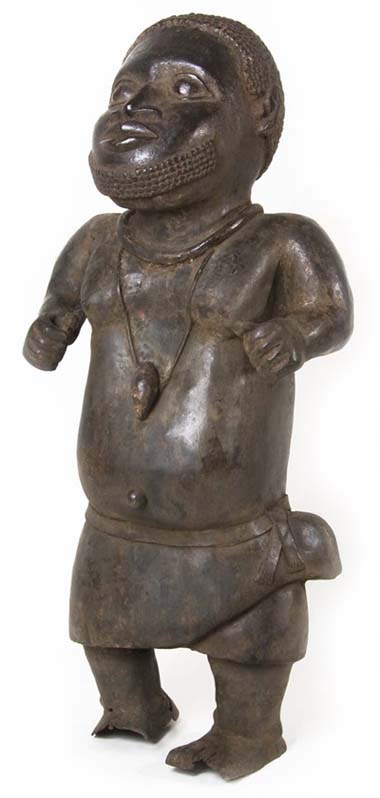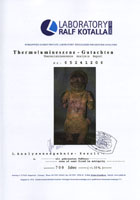This object, estimated at circa 700 years old, is one of the oldest in the exhibition. Certain of its attributes - the deformation of the spine and head, the compressed forearms and the sunken chest - indicate that it depicts a dwarf. In Benin, physical deformities were traditionally associated with specific functions at the palace. Little people often lived at the royal palace of Benin as court dwarves and jugglers, their mere appearance apparently considered amusing (an historical assumption that is feasible but not verifiable).
The unusually individualistic rendering of physical traits in this sculpture - the hair, for example, the accentuation of the beard and the special posture typical of little people - attests not only to a high level of artistic skill on the part of the casting guilds, but also to the prestige of this dwarf. In fact, the responsibilities of the dwarf extended beyond entertainment to care of shrines, market surveillance and intelligence gathering for the Oba. That this dwarf was accorded the honour of having a memorial made for him from the then-precious material bronze is a clear indication of his important position at the royal palace.
Though statues of dwarves were not part of the standard inventory of an altar, this bronze was probably made for an ancestral shrine; the very individualized traits indicate a concrete portrait, for the most part uncommon in Beninese art. Evidently, the casting tradition in Benin was not yet as scrupulously codified at the time of the creation of this object as it later would become.
Stylistically speaking, both the dwarf's ears and his facial characteristics clearly refer to Benin. It follows that the Benin bronze casting tradition must have already been quite well-developed at the time this bronze was made, around 1300. This throws into question the argument that the bronze tradition grew out of Ife and was only adopted in Benin beginning in the 14 th century. Given its approximate 700 years and its strikingly high quality, this dwarf serves as proof that a highly-developed bronze casting tradition existed in Benin as early as 1300, thereby repudiating all theories holding that the origin of the tradition lies in Ife. So too does this object disprove the theory that the Portuguese brought bronze to Benin, for trade between Portugal and Benin only began in the 15 th century. With the exception of the feet, this object is extremely well preserved for its age. The only very similar piece we know of is housed in the Museum of Ethnology in Vienna.
The darf was restaured in 2008 by Peter Herrmann. The surface was very dirty and corroded.
Cp.:
Felix von LUSCHAN: Die Altertümer von Benin, Band 1, Berlin 1919, S. 299/ 300.
Philip J. C. DARK: An introduction to Benin art and technology, Oxford 1973, S. 97.
Paula Girshick BEN-AMOS: The art of Benin, London 1995, S. 43.
Barbara PLANKENSTEINER (Hg.): Benin. Könige und Rituale. Höfische Kunst aus Nigeria, Wien 2007, S. 308 - 311. |


